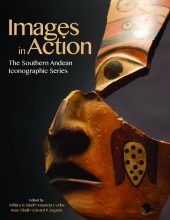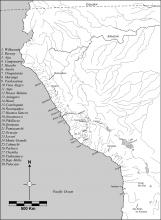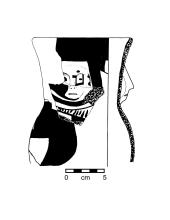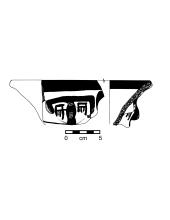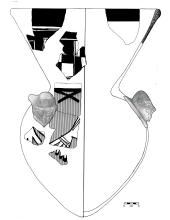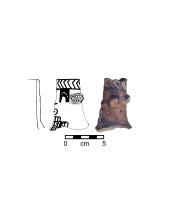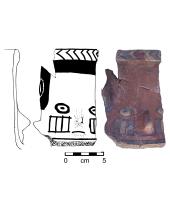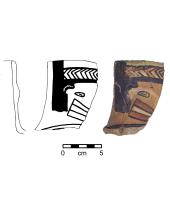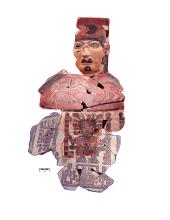Visual database
Central Andean map. Names of modern cities and geographic features are printed on map while archaeological sites are numbered from northern Peru to northern Chile and Bolivia. Courtesy of Patricia J. Knobloch.
Black-on-white effigy jar from the earliest known collection of Huarpa-style ceramics. This vessel fragment and those in Figures 23.3 and 23.4 were found at Huari in cultural layers of occupational deposition exposed by a modern road cut west of the Capilla Pata building. Associated with a 14C date (BP 1713 ± 120) cal. AD 245 to AD 520 at 1-sigma set for Southern Hemisphere in CALIB 7.1. Diameter = 12 cm. Collected in 1974 by William H. Isbell, Katharina J. Schreiber, and author. Courtesy of Patricia J. Knobloch.
Black-on-white effigy vessel, most likely a jar because the interior was painted white as common with Huarpa black-on-white wide-mouthed jars. Huarpa black-on-white bowl sherds have an unpigmented interior below the black rim band. Diameter = 21 cm. Courtesy of Patricia J. Knobloch.
Suggested reconstruction of a large jar shape though the thick rim sherds were previously ascribed to large, "vertical sided open vessels" (Menzel 1964:9). The jar would have had two strap handles and, possibly, a modeled head located on or about the shoulder. Above the neck, the interior was painted white and the exterior a black-on-white checkerboard pattern. Below the neck, the exterior was painted with black and white on brown hand-like motifs. Diameter = 48 cm. Courtesy of Patricia J. Knobloch.
Schematic drawing of unit Eb4-2-200 excavated at Huari in 1977 by Dr. Isbell's Huari Urban Prehistory Project. Initial excavation removed layers in a profile unit next to the road cut in order to expose and more clearly discern the layers that were then excavated in the 2-m x 2-m unit. The lowest levels contained a Huarpa occupation with architectural features, followed by early Huari occupation of Epoch 1A with further wall construction, then general occupational deposition into Middle Horizon Epoch 1B. The area within the 2-m x 2-m square above Stratum 14 was badly disturbed and therefore analysis continued with data collected from the profile square. Courtesy of Patricia J. Knobloch.
Ocros-style Agent 102 effigy jar sherd from Unit Eb4-2-200, Stratum 4 and assigned to middle Epoch 1B (AD 750-775). Diameter = 3 cm. Courtesy of Patricia J. Knobloch.
Chakipampa-style Agent 102 effigy jar sherd from Unit Eb4-2-200, Stratum 5 and assigned to middle Epoch 1B (AD 750-775). Diameter = 10 cm. Courtesy of Patricia J. Knobloch.
Ocros-style Agent 102 effigy jar sherd from Unit Eb4-2-200, Stratum 22 assigned to a transitional time between Epoch 1A and Epoch 1B (circa AD 725). Diameter = 8 cm. Pendent rectangle on cheek is horizontal. Courtesy of Patricia J. Knobloch.
Composite of two effigy jar fragments from 1977 Conchopata offering excavation. The face on the neck depicts an individual assigned to the Agent 102 category who wears a chevron band headdress. Humped-animals face each other on the jar's shoulder. On the jar's body, the Staff God stands on a pedestal with two rows of stylized Profile Deities facing toward and away from the Staff God. Assigned to late Epoch 1B (AD 750-775). Courtesy of William H. Isbell.
Profile of stratigraphy in the 1977 pipeline trench at Conchopata site. Drawn from field drawings by Perry Gnivecki. Units A and C were 2-m x 2-m excavations to bedrock. A group burial (not shown) was located between Unit A and the Offering Pit. Remnant walls at either end delimit a possible plaza with a pink sandy floor. Courtesy of Patricia J. Knobloch.
